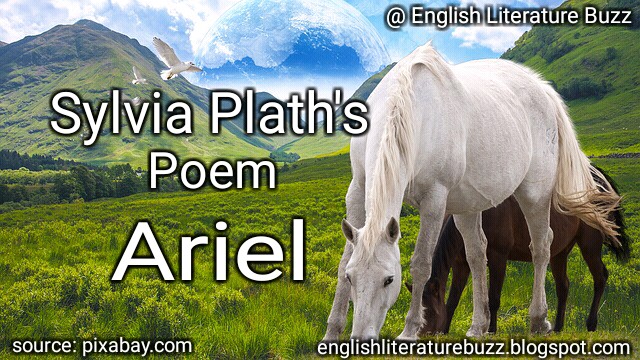Sylvia Plath: Ariel
Ariel is Plath’s most furious poem. Without naming names she lashes back at everybody who contributed to her near- insanity; her parents, especially her mother, the siblings, her lovers, especially her husband, male community in general, and the society at large; though furious imagery and, at times, diction too. Ariel is, therefore, her most subjective, richly autobiographical poem.
Sylvia Plath is such an American writer whose best- known poems are noted for their personal imagery and intense focus. Plath wrote only two books before her suicide at the age of 31. Her posthumous Ariel (1956) astonished the literary world with its power, and has become one of the best-selling volumes of poetry published in England and America in the 20th century. Plath was married to the poet Ted Hughes.
Out of the ash
I rise with my red hair
And I eat men like air
Most poems of Sylvia Plath bear out a personal tinge of her own life. One never knows why did Sylvia Plath’s soul suffered so deeply.
Actually the poem Ariel is a concentration of the physical and emotional suffering of a woman. The poem Ariel begins with the words:
Ariel stasis in darkness.
Then the substanceless blue
Pour of tor and distances
The poetess is going through a trance early in the morning: it is an ecstasy; it is an effort to transcend herself beyond the ethereal life; she wishes to have a comic union.
God’s lioness,
How one grow,
Pivot of heels and knees!
- the furrow splits and passes, sister to
The brown arc
Of the neck I cannot catch,
God’s lioness is the woman who offers herself to male cruelty for procreation. The poem starts in an ominous state of dark inactivity phrased by Plath as “stasis in darkness.” The image of a horse running at break-neck speed with a rider hanging on its neck finally blurs into a fusion of the horse and the rider.
Speaking of the genesis of Ariel, ted Hughes say:
"Ariel was the name of the horse on which she went riding weekly. Long before, while she was a student at Cambridge (England), she went riding with an American friend out towards Grantchester. Her horse bolted, the stirrups fell off, and she came all the way home to the stables, about two miles at full gallop, hanging around the horse’s neck."
The event occurred in 1956. It was recalled and narrativised in Ariel. That suicidal ride back in1956 had much in common with Plath’s life.
She further says that the black eyes of the nigger which look like sweet black berries which children shake off the trees with hooked strikes and eat in sweet mouthfuls then there are other images. Images like dead hand, nigger –eyes, black sweet blood, suicidal dew flying in the air, and cauldron of morning, all indicate to the personal torment of poetess soul.
Sylvia’s poems comes out of her deep sensuous and emotional experiences. ‘Woman’ is also an integral part of her poetry. Transfiguration of death is more or less like that Emily Dickinson’s vision of death. Emily’s poem ‘Because I could not stop for death’, can be quoted.
In the last few months of her life she wrote her most widely acclaimed poem ‘Daddy’. In this poem she alluded to her first attempt at suicide at the age of 20, saying “At twenty I tried to die … But they pulled me out of the sack and they stuck me together with glue.” Her second attempt on January 7, 1963 was successful. But the popularity of her works and curiosity about her life again got her stuck together in paper form. Her posthumously published collection of poetry, especially the fierce and mythic “Ariel” turned out to be one of the most widely read best- sellers of the 20th century.
Related Topics:
Mourning Becomes Electra: Art of Characterization
For Whom The Bells Toll: Jordan relationship with Maria

